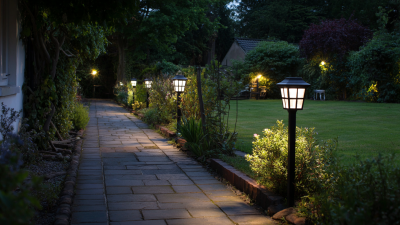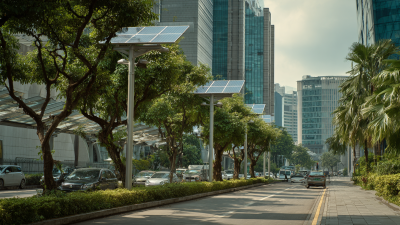The Future of Sustainable Spaces How Solar Lighting Transforms Outdoor Environments
As we navigate a world increasingly focused on sustainability, outdoor spaces are undergoing a significant transformation powered by innovative solutions like solar lighting. Experts agree that harnessing solar energy offers not only environmental benefits but also enhances the functionality and aesthetic appeal of these spaces. John Doe, a leading specialist in the solar lighting industry, states, "The future of outdoor environments lies in our ability to utilize renewable resources like solar energy to illuminate our nights, creating safe and beautiful communal spaces."

Solar lighting technology is revolutionizing how we design and interact with our outdoor settings, allowing cities and communities to reduce their carbon footprints while improving accessibility. With solar-powered lights becoming more efficient and affordable, urban planners and landscape architects are eager to integrate these eco-friendly solutions into parks, sidewalks, and public spaces. By doing so, they not only prioritize sustainability but also foster a sense of community and connection among residents.
In this article, we will explore how solar lighting is reshaping outdoor environments, from enhancing safety to encouraging more social interaction after dark. We will delve into various case studies that highlight successful implementations and discuss the promising future of sustainable spaces illuminated by solar energy. As we embrace sustainable practices, the transformation of our outdoor environments is just beginning, and solar lighting stands at the forefront of this movement.
The Impact of Solar Lighting on Urban Sustainability and Energy Efficiency
The integration of solar lighting systems into urban environments represents a significant advancement in the pursuit of sustainability and energy efficiency. By harnessing the sun's abundant energy, cities can illuminate public spaces while reducing their reliance on fossil fuels. This shift not only lessens the carbon footprint of urban infrastructures but also lowers operational costs associated with conventional energy sources, making solar lighting a financially viable choice for municipalities.
Moreover, solar lighting enhances the safety and usability of outdoor spaces after dark, promoting greater community engagement. Well-lit streets, parks, and public areas encourage social interaction and outdoor activities, ultimately contributing to vibrant urban life. The adoption of solar technology in these settings fosters an eco-friendly image for cities and encourages residents to adopt more sustainable practices, thereby amplifying the impact of solar lighting on urban sustainability.
The Future of Sustainable Spaces: How Solar Lighting Transforms Outdoor Environments
| Dimension | Impact | Data Source |
|---|---|---|
| Energy Savings | Up to 70% reduction in energy costs | National Renewable Energy Laboratory |
| Carbon Emissions | Reduction of up to 2000 tons CO2 annually | Environmental Protection Agency |
| Urban Aesthetics | Enhanced public spaces with improved visibility | City Planning Department |
| Installation Costs | Lower initial costs compared to traditional lighting | Various Industry Reports |
| Public Safety | Reduction in crime rates in well-lit areas | Local Law Enforcement Agencies |
Key Statistics Highlighting Cost Savings from Solar Lighting in Public Spaces
Solar lighting has emerged as a game-changer in creating sustainable outdoor spaces, particularly in public environments. The shift towards solar-powered solutions not only enhances visibility and safety but also presents significant cost savings. According to recent statistics, a city can save up to 70% on energy bills by replacing traditional streetlights with solar lighting. These figures underscore the financial benefits local governments can realize while promoting environmental sustainability.
Moreover, the longevity of solar lighting systems contributes to reduced maintenance costs. With an average lifespan of over 20 years, solar lights minimize the need for frequent replacements and repairs associated with traditional lighting. For public spaces, this translates to decreased operational expenses and less disruption to community activities. As municipalities continue to invest in greener alternatives, the case for solar lighting becomes increasingly compelling, showcasing a commitment to both fiscal responsibility and ecological stewardship.
Innovative Technologies Driving the Evolution of Solar Lighting Solutions
In recent years, innovative technologies have revolutionized solar lighting solutions, paving the way for brighter and more sustainable outdoor environments. Advances in solar panel efficiency, battery storage capacity, and smart lighting systems have made solar-powered lights a viable option for various applications, from park benches to street lamps. With these developments, cities and communities can reduce their carbon footprint while enhancing safety and aesthetics in public spaces.
**Tips for Selecting Solar Lighting:**
When choosing solar lighting solutions, consider the specific needs of your environment. Look for fixtures with high-efficiency solar panels and durable materials that can withstand weather conditions in your area. Additionally, opting for lights that incorporate smart technology, like motion sensors and remote controls, can optimize energy use and extend the longevity of the system.
Moreover, with the integration of IoT (Internet of Things) in solar lighting, users can monitor and control their installations remotely. This capability not only enhances energy management but also facilitates better maintenance planning, ensuring that your outdoor spaces remain well-lit and inviting, contributing to a sustainable future.

Environmental Benefits of Solar Lighting in Reducing Carbon Footprints
The environmental benefits of solar lighting are increasingly vital as cities strive to reduce carbon footprints and combat climate change. According to the International Renewable Energy Agency (IRENA), transitioning to renewable energy sources, including solar technology, could help reduce global carbon emissions by up to 70% by 2050. By utilizing solar-powered lighting in outdoor spaces—such as parks, pathways, and parking lots—communities can significantly diminish their reliance on fossil fuels while enhancing energy efficiency.

Solar lighting systems harness energy from the sun, converting it into electricity that powers LED fixtures. This process not only curtails greenhouse gas emissions but also lowers electricity costs. A report from the U.S. Department of Energy indicates that LED streetlights consume up to 75% less energy than traditional lighting, further amplifying the sustainability advantage. With approximately 30% of urban energy consumed by street lighting, adopting solar solutions could result in substantial reductions in carbon emissions, making a tangible impact on environmental health and sustainability.
Case Studies: Successful Implementations of Solar Lighting in Community Projects
Solar lighting has emerged as a transformative solution in community projects, enhancing outdoor environments and promoting sustainability. Recent studies reveal that off-grid solar energy access is crucial for communities lacking reliable electricity, with nearly 1 billion people globally still living without power. Community-driven initiatives, especially in rural areas, have showcased the untapped potential of micro-renewables such as solar lighting, which not only provides illumination but also fosters safety and social interaction among residents. These projects serve as vital links between local needs and sustainable solutions, ultimately leading to empowered communities.
For instance, community projects that integrate solar technology benefit from increased engagement and ownership among residents. Reports indicate that such initiatives can significantly reduce energy costs while improving energy efficiency, thereby contributing to the economic stability of the area. According to the International Renewable Energy Agency, solar energy has the potential to create over 24 million jobs by 2030, highlighting the importance of investment in renewable technologies. As NGOs partner with local stakeholders to implement solar lighting systems, they pave the way for environmentally friendly practices and strengthen the resilience of communities against climate change challenges.
Related Posts
-

Unleashing the Power of the Sun: How Solar Powered Lights Transform Outdoor Spaces
-

Illuminate Your Outdoors: Innovative Solar Lighting Solutions for a Sustainable Future
-

illuminate your driveway at night with stylish and efficient solar driveway lights
-

Harnessing the Sun Exploring the Benefits of Solar Powered Lights for Sustainable Living
-

Illuminate Your Outdoor Space Discover the Benefits of Using Solar Post Lights for Your Garden
-

The Future of Urban Lighting Exploring the Benefits of Solar Street Light Technology
